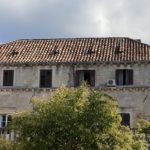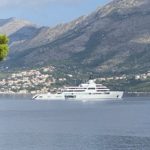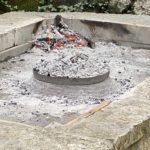
Esparreguera The harbor at Cavtat, Croatia
http://ornamentalpeanut.com/wp-includes/Requests/Text/ We left La Perla before nine and boarded our bus for Cavtat. At Cavtat we caught up with Paolo for a walking tour. The bay here is very well protected cut back into the shore and protected by three islands near its mouth: St Barbara, St Peter, and St Mark. Remember: the majority of Croatia’s citizens are Catholic. The town is home now to only 2500 people. It is the last town in southern Croatia (Montenegro is less than 30 minutes south) and serves as the administrative center for the area. The bay itself ranges from 3 to 30 feet deep and is bordered by a palm lined promenade with shops and restaurants.

The palm lined promenade at Cavtat. The palms are closely monitored since they are under attack by weevils who weaken the trees until the tree dies.
As the southern entry point to the Adriatic, it became a significant trading point for ancient Greeks. In 168 BC, Cavtat was taken over by the Romans. Since the residents pledged their allegiance to Julius Caesar, it was a peaceful takeover and Caesar granted them the title of a Roman Colony, affording them status and a certain degree of autonomy.
When the Slav invaders came, they flattened the town and eliminated any vestiges of the Romans. At that time Cavtat had 40,000 residents, only 8 families survived and as refugees they moved up the coast to develop Dubrovnik.
Water polo is a big sport and we were fortunate to spot a match during our visit. As we walked by the bay, Paolo pointed out that the sea urchins protect themselves from the UV rays of the sun by hiding under shells and pieces of stone. May tourists think the male sea urchins are decorating themselves to attract females or that the females decorate themselves with “jewelry.” These sea urchins thrive where the waters are very clear and clean. So they are a good sign for swimming, but can be difficult if a swimmer steps on them.
Paolo shared a tidbit that Yugoslavia was one of the first countries that opened to a nudist colony. In fact, King Edward 8 and Wallis Simpson asked for permission to swim and sunbathe nude during a visit here and, of course, it was granted.
We passed a structure with a brownish tile roof. Paolo explained that it was one of the original roofs of clay tile. The tiles are usually 10 inches long, weighed a lot, and made by potters in Dubrovnik in medieval times. Usually the potter shaped the tile over his thigh, resulting in its curved shape.
Franciscans were sent in 1427 to convert population to Catholicism. Over time they constructed the Monastery of Our Lady of the Snow, so named for a legend about it snowing in August. The complex is cloistered, one story, and rectangular with a church in the eastern end and a garden in the north wing. A cistern was built in 1878 for the use of sailors. The roof was currently being replaced.
Pine trees were planted to replace the vineyards killed by the phylloxera epidemic, introduced by botanists from Victorian England who collected specimens from American vines in the 1850’s. Europe and especially France were hit very hard.
As we walked around the peninsula, we saw a huge boat belonging to a Russian businessman who owns or used to own the Chelsea soccer team. He supposedly paid 610 million dollars US for it, but it was not, in my opinion, a very attractive boat. It did have a huge “garage” to house his toys like runabouts, jet skis, etc. So maybe its attractiveness was its functionality.
We left Cavtat and headed a bit farther south to Gruba, where we met Ivor whose family has owned an old mill for generations. We were greeted with a snack of figs, sweetened orange rind, and almonds accompanied by various brandies. I tried the loquat brandy: it was sweet and scrumptious. They also had walnut brandy, grappe, and cherry brandy.
The mills were built in the 16th century to harness the power of water to make daily life in the countryside easier. At one point there were 10 mills for grinding corn and flour, a few used in the process of making olive oil, and a few for fulling wool (the process of beating it to compress the fibers into a tighter weave.) Use of the mills ceased in 1965 but between 20 and 15 years ago, Ivor’s family reconstructed two of them by fabricating new wooden parts to make them operational.
After touring the mills, we were afforded a lunch of ham (prosciutto) and cheese, warm bread baked under a steel dome and wood fire, and, of course, local red or white wine.
Then, back to La Perla to prepare for our farewell dinner and to prepare for tomorrow’s departure.





































